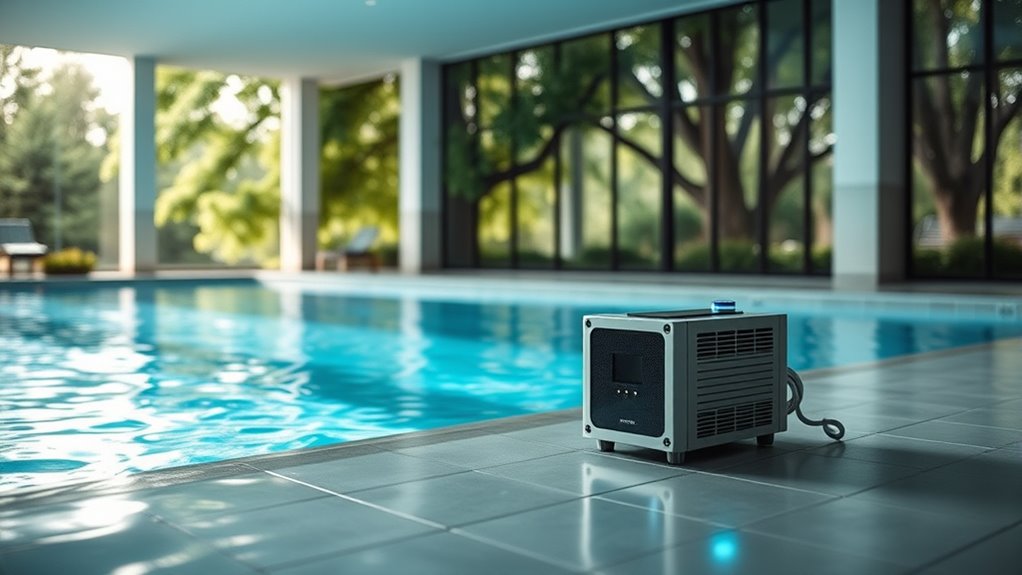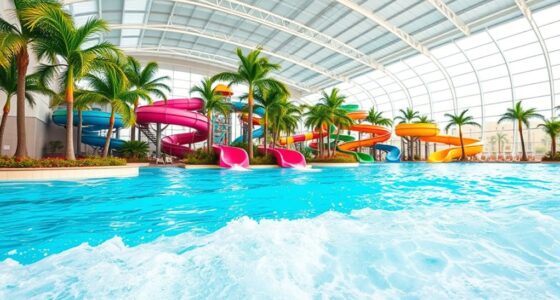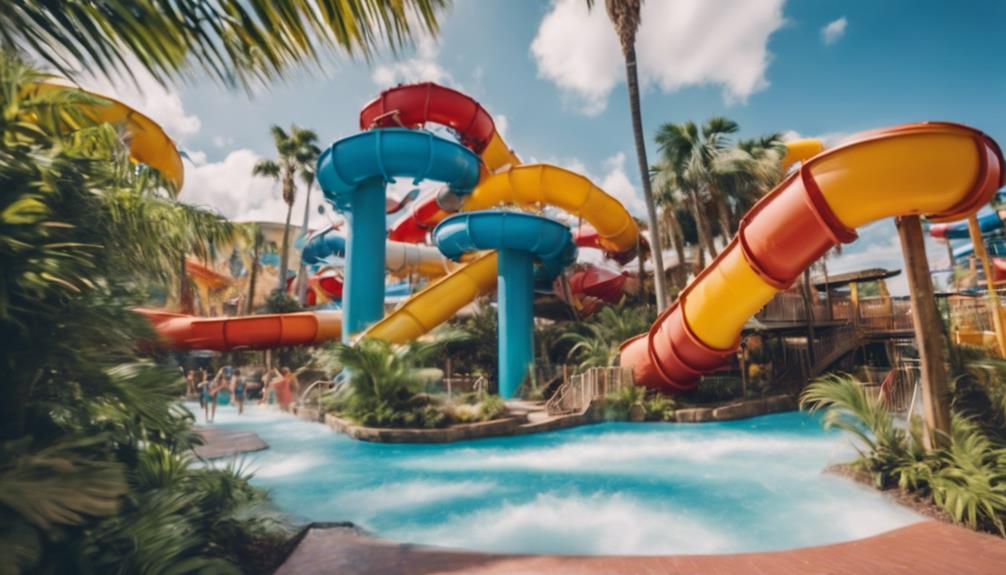Indoor pool smells mainly come from chloramines, which form when chlorine reacts with sweat, urine, and oils from swimmers. These compounds build up when ventilation isn’t enough, causing strong odors and irritation. To manage this, parks typically improve water chemistry, boost ventilation, and use treatments like UV or ozone systems. If you want to understand how these strategies help keep the air fresh and healthy, there’s more to discover below.
Key Takeaways
- Chloramine formation from swimmer organic matter reacts with chlorine, causing strong odors in indoor pools.
- Proper water chemistry, including pH and chlorine levels, reduces chloramine buildup and associated smells.
- Adequate ventilation and HVAC systems help disperse chloramine vapors, preventing odor accumulation indoors.
- Regular showering, rinsing, and enforcing hygiene rules decrease organic contaminants that form chloramines.
- Pools implement targeted air extraction, supplemental treatments, and staff training to control odors effectively.
Understanding the Cause of Pool Odors
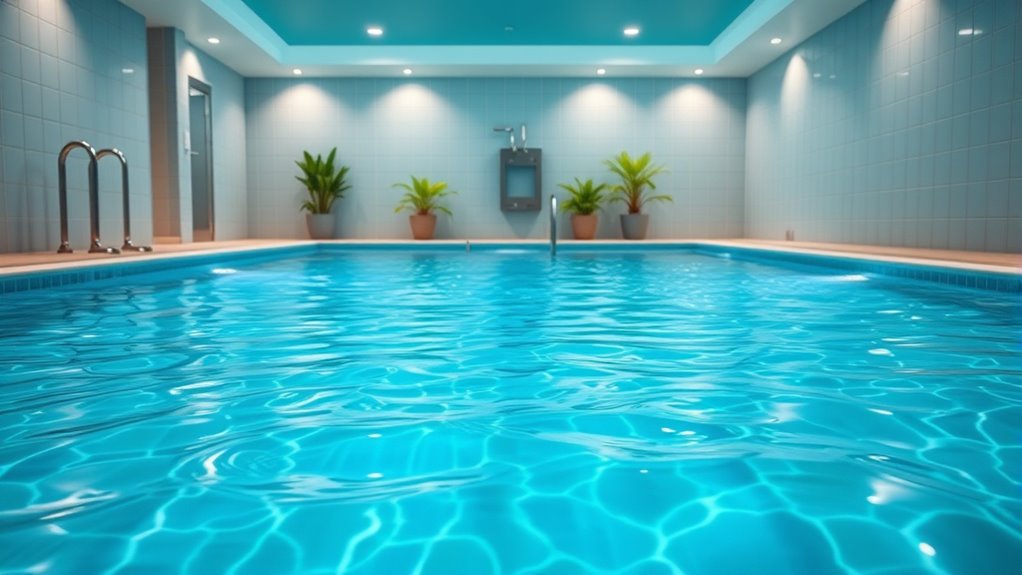
To understand the cause of pool odors, it’s important to know that chloramines form when chlorine reacts with organic matter like sweat, oils, and urine. These compounds are introduced by swimmers and quickly react with disinfectants, creating chloramines, which are responsible for the strong smell. Environmental factors like temperature, humidity, and poor ventilation can intensify the odor. Warmer water and higher temperatures increase chloramine volatility, making the smell more noticeable. Additionally, when air circulation is limited, chloramines build up, worsening the odor and air quality. It’s a common misconception that chlorine itself causes the smell; instead, chloramines are the primary source. Recognizing this helps you understand why indoor pools often smell stronger and how environmental conditions influence odor intensity. Proper pool chemistry management, including maintaining appropriate chlorine and chloramine levels, can significantly reduce these odors and improve air quality. Adequate ventilation systems are crucial in dispersing chloramine vapors and maintaining a fresh indoor environment.
The Formation of Chloramines in Indoor Pools

Chloramines form when organic contaminants like sweat, urine, and dirt react with chlorine in your pool water. Ammonia from human waste plays a key role, creating compounds that turn into chloramines. As bather load increases and hygiene habits slip, these reactions accelerate, leading to stronger odors and air quality issues. Chloramines are formed as chlorine reacts with nitrogen and carbon contaminants, which can continue to build up if not properly managed.
Organic Contaminants Reaction
Organic contaminants such as sweat, urine, and skin oils introduced by swimmers react with chlorine in indoor pools to form chloramines. When chlorine encounters these organic substances, it oxidizes them, creating nitrogen- and carbon-based compounds. This process generates various chloramines, including monochloramines, dichloramines, and trichloramines. The formation begins with chlorine reacting with nitrogen compounds from bather waste, producing monochloramines, which can further react to form dichloramines and trichloramines. These reactions are influenced by the amount of organic matter present and the amount of free chlorine available. As chloramines accumulate, they release into the air or remain dissolved in water, contributing to the characteristic smell and irritation. Proper management involves controlling organic load and maintaining appropriate chlorine levels to minimize chloramine formation. Monitoring levels of chloramines regularly helps in assessing the effectiveness of water treatment and controlling odors.
Ammonia’s Role in Formation
Ammonia plays a key role in forming chloramines in indoor pools, primarily entering the water through swimmers’ urine and sweat. Once in the water, ammonia reacts with hypochlorous acid—the active form of chlorine—to create chloramines. This reaction starts with monochloramine formation, where ammonia’s hydrogen ions are replaced by chloride ions. These chloramines, including monochloramine and dichloramine, are waterborne, while trichloramine becomes airborne, affecting indoor air quality. Factors like warmer water, higher bather loads, elevated chlorine levels, and poor water circulation accelerate chloramine formation. As a result, chloramines can cause eye irritation, respiratory issues, and indoor air quality problems. Managing these factors through hygiene, proper chlorination, and ventilation helps control chloramine buildup and improves pool environment safety. Proper chemical management is essential to prevent excessive chloramine formation and maintain a healthy indoor pool environment. Additionally, understanding water chemistry is vital for optimizing disinfection processes and reducing harmful byproducts.
Health Impacts of Chloramine Exposure
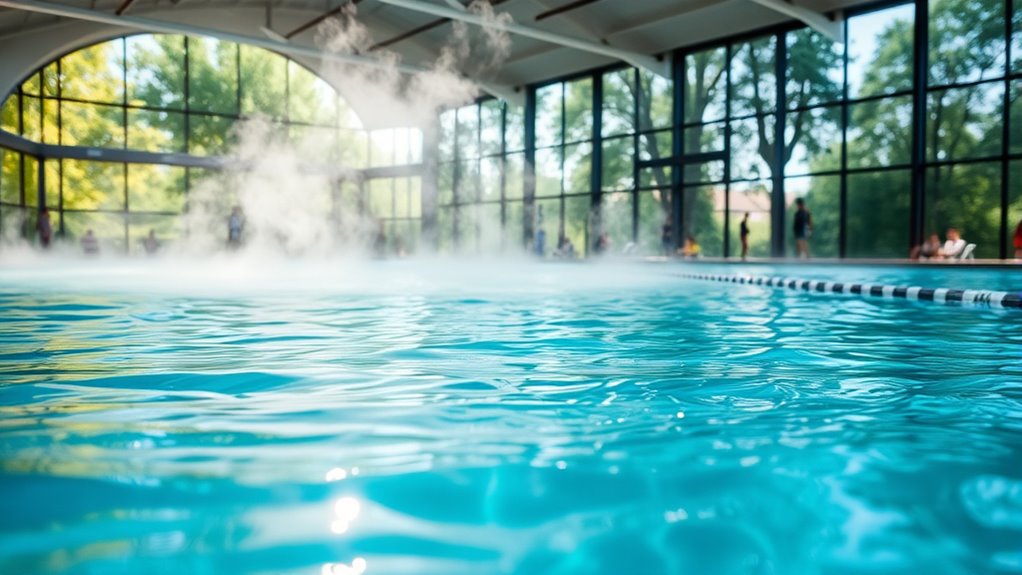
When you’re exposed to chloramine, you might notice respiratory symptoms like coughing, throat irritation, or worsened asthma. It can also cause eye and nose irritation, especially at higher concentrations. Chloramines can denature hemoglobin, leading to anemia in dialysis patients. Understanding these health impacts helps you take steps to reduce your risk and protect your well-being. Additionally, electric dirt bikes often produce between 10 to 20 horsepower, offering comparable power to traditional gas-powered bikes and instant torque for quick acceleration.
Respiratory Health Risks
Inhaling chloramine fumes during indoor swimming can cause immediate respiratory irritation, leading to symptoms like coughing, wheezing, and shortness of breath. Prolonged exposure, especially in poorly ventilated pools, worsens these effects. Frequent swimmers, staff, and children are particularly vulnerable to persistent issues. Chronic exposure may cause ongoing wheezing, lung function decline, and airway inflammation. You might experience:
- Long-lasting reductions in lung capacity
- Structural lung damage, such as fibrosis
- Increased airway inflammation and hyper-responsiveness
These effects resemble irritant-induced asthma or RADS and can lead to serious conditions like bronchiolitis obliterans. If you spend a lot of time in indoor pools, your respiratory health could be at risk, especially without proper ventilation and protective measures. Poor ventilation exacerbates the inhalation of chloramine fumes, leading to more severe health consequences. Additionally, health impacts of chloramine exposure can be amplified in environments lacking adequate air exchange.
Skin and Eye Irritation
Exposure to chloramines in indoor pools doesn’t just affect your lungs; it can also cause noticeable skin and eye irritation. When chloramines contact your skin, they may cause redness, itching, and discomfort. Prolonged exposure can dry out your skin, leading to cracking and persistent itchiness. In your eyes, chloramines can cause redness, watering, and irritation, especially in indoor pools with rising gases. Wearing goggles helps protect your eyes, while showering immediately after swimming removes chloramine residues from your skin. Both chlorine and chloramine can cause irritation, but chloramine’s gaseous form often worsens eye discomfort indoors. Chloramines are formed when chlorine reacts with organic matter, making proper pool maintenance and ventilation essential to reduce these irritations, helping you enjoy swimming without suffering from skin or eye issues. Proper ventilation systems can significantly reduce chloramine gas buildup, further improving indoor pool air quality and swimmer comfort.
Challenges Unique to Indoor Swimming Facilities
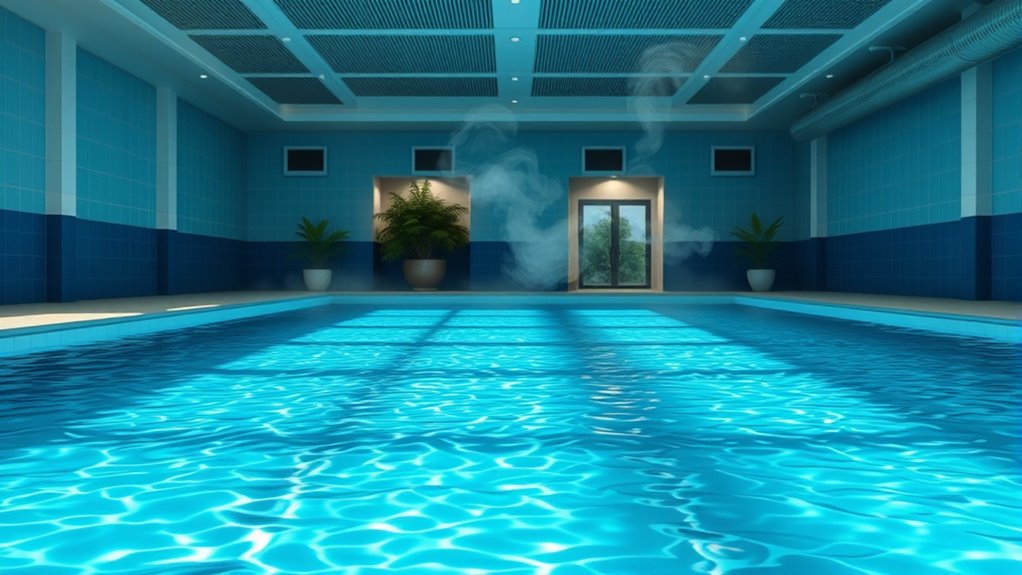
Indoor swimming facilities face unique challenges in managing chloramine smell due to the need for precise environmental control. Maintaining ideal temperature (82–85°F) and humidity (50-60%) is essential, but faulty HVAC systems, blocked air intakes, or broken exhaust fans often lead to elevated humidity and temperature. This promotes chloramine vapor release and odors. This is especially problematic because ventilation capacity is often insufficient, making it difficult to disperse chloramine vapors effectively, which can exacerbate odor issues. Higher water-to-air temperature differences increase evaporation, intensifying odor problems indoors. Adequate ventilation and fresh air exchange are critical but difficult to achieve because of building design or equipment issues. These challenges cause:
- Accelerated corrosion of fixtures and degradation of materials due to persistent humidity and chloramine exposure.
- Increased maintenance costs from ongoing repairs and material deterioration.
- Operational complexities in balancing water chemistry, air quality, and energy efficiency under tight budgets.
Effective Strategies to Minimize Chloramines
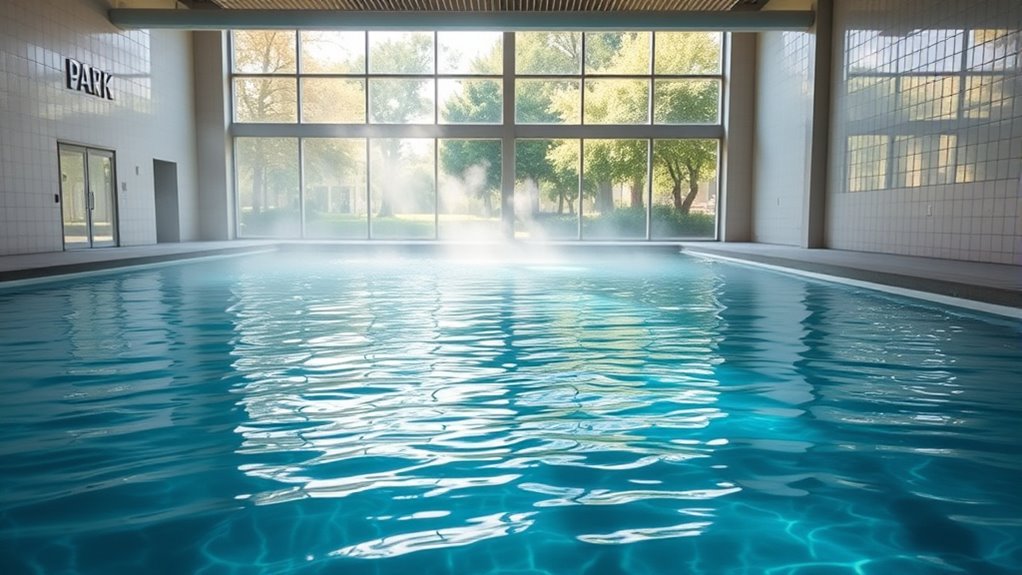
Implementing effective strategies to minimize chloramines begins with controlling their source. Start by encouraging swimmers and staff to rinse thoroughly before entering the pool, reducing oils, sweat, and urine that form chloramines. Post clear signs reminding everyone to shower, use toilets properly, and avoid urinating in the pool. Enforce rules to prevent swimmers with diarrhea from entering, protecting water quality. Using bathing caps can cut down on sweat and personal care products entering the water. Quickly addressing fecal incidents with designated cleanup protocols prevents chloramine spikes. Regular shock treatments with either traditional chlorine or non-chlorine oxidizers like hydrogen peroxide break down chloramines. Maintaining proper water chemistry, especially pH levels between 7.2 and 7.6, also guarantees chlorine remains effective in controlling chloramines. Proper chlorine management ensures that free available chlorine stays at levels that efficiently break down chloramines without causing excessive odors or irritation. Additionally, implementing professional water testing helps monitor and sustain optimal water quality standards.
What Parks Are Doing to Improve Pool Air Quality
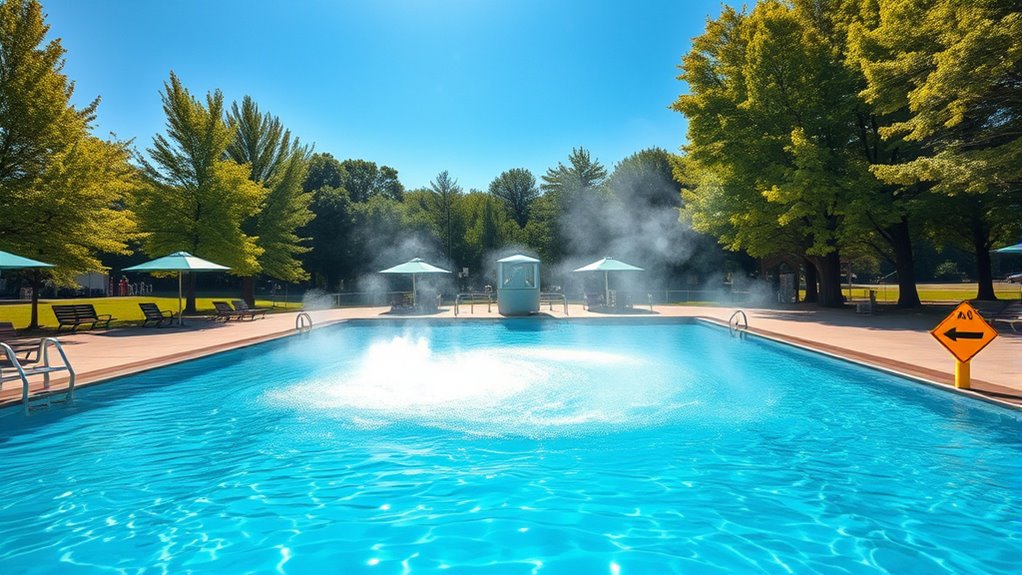
To improve pool air quality, parks are adopting a range of ventilation enhancements that effectively reduce chloramine concentrations. They use well-designed HVAC systems with increased outdoor airflow during operational hours to dilute contaminated air. Indoor pools maintain slight negative pressure to prevent chloramine-laden air from spreading, aided by automatic door closers. Targeted air extraction at low-level return vents pulls chloramine-rich air directly from the water’s surface, boosting removal efficiency. Additionally, strategic ductwork ensures even air distribution, preventing pockets of poor air quality. Automated controls, using occupancy sensors or timers, balance ventilation needs with energy efficiency. These measures, combined with supplemental treatments like UV and ozone systems, markedly improve indoor air quality and reduce the chloramine smell you notice. Implementing ventilation standards based on current best practices is essential for maintaining a healthy indoor environment.
Frequently Asked Questions
How Can Swimmers Reduce Their Contribution to Chloramine Formation?
You can reduce your contribution to chloramine formation by showering with soap before entering the pool, washing off sweat, oils, and cosmetics. Avoid urinating in the water and don’t apply lotions or deodorants beforehand. Stay hydrated to lessen the urge to urinate and minimize introducing ammonia. Using goggles and swim caps, along with following pool hygiene policies, also helps keep chloramine levels low and improves water quality for everyone.
Are There Safer Alternative Disinfectants for Indoor Pools?
Yes, you can use safer alternatives like bromine, ozonation, or saltwater systems for indoor pools. These options reduce harsh chemical odors and irritation, making swimming more comfortable. Bromine is gentler on skin and eyes, ozonation oxidizes contaminants effectively, and saltwater systems naturally produce chlorine with fewer chemicals. Talk to pool professionals to find the best, safest solution tailored to your indoor pool’s needs.
How Often Should Indoor Pools Be Tested for Chloramine Levels?
You should test indoor pools for chloramine levels at least twice a week—more if it’s crowded or hot, because organic buildup speeds up. When bather numbers spike or after storms, test daily, even multiple times if needed. Think of it as your pool’s health check-up: the more you monitor, the better you catch issues before everyone starts smelling like a chemical experiment gone wrong.
What Are the Costs of Installing Advanced Air Circulation Systems?
Installing advanced air circulation systems costs between $4,000 and $20,000, depending on pool size, enclosure complexity, and system features. You might pay more for energy-efficient options, corrosion-resistant components, or digital controls. The initial investment varies based on factors like ventilation capacity and additional equipment such as vapor barriers or duct heaters. While costly upfront, these systems can reduce long-term expenses by improving air quality, lowering chemical use, and extending equipment lifespan.
Can Personal Protective Equipment Prevent Chloramine Inhalation?
Sure, PPE can prevent chloramine inhalation—if you’re willing to wear it all day long, even during pool hours. In reality, PPE is your backup plan, not the main defense. Engineering controls and administrative policies do most of the work. When used properly, PPE offers critical protection during high exposure or emergencies, but relying solely on it isn’t practical. Stay aware, follow safety guidelines, and don’t skip the other controls.
Conclusion
To tame troubling chloramine smells, take proactive steps and promote proper pool practices. By blending better ventilation, vigilant water management, and vigilant maintenance, you can markedly reduce odors and health hazards. Parks are already pioneering practices to improve pool air quality—now, it’s your turn to take action. With committed care, you can create a cleaner, fresher, and more comfortable aquatic environment for everyone to enjoy. Let’s lead the way toward a fresher, fuss-free pool experience!

